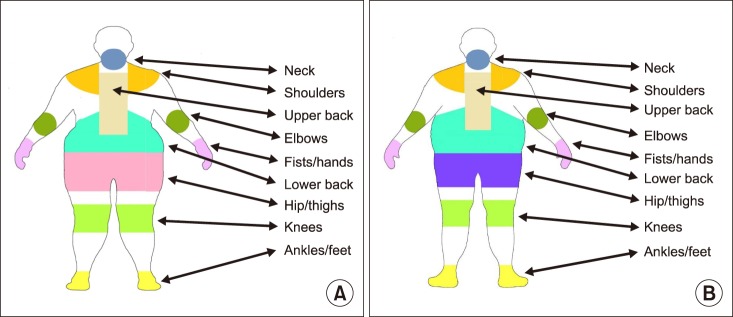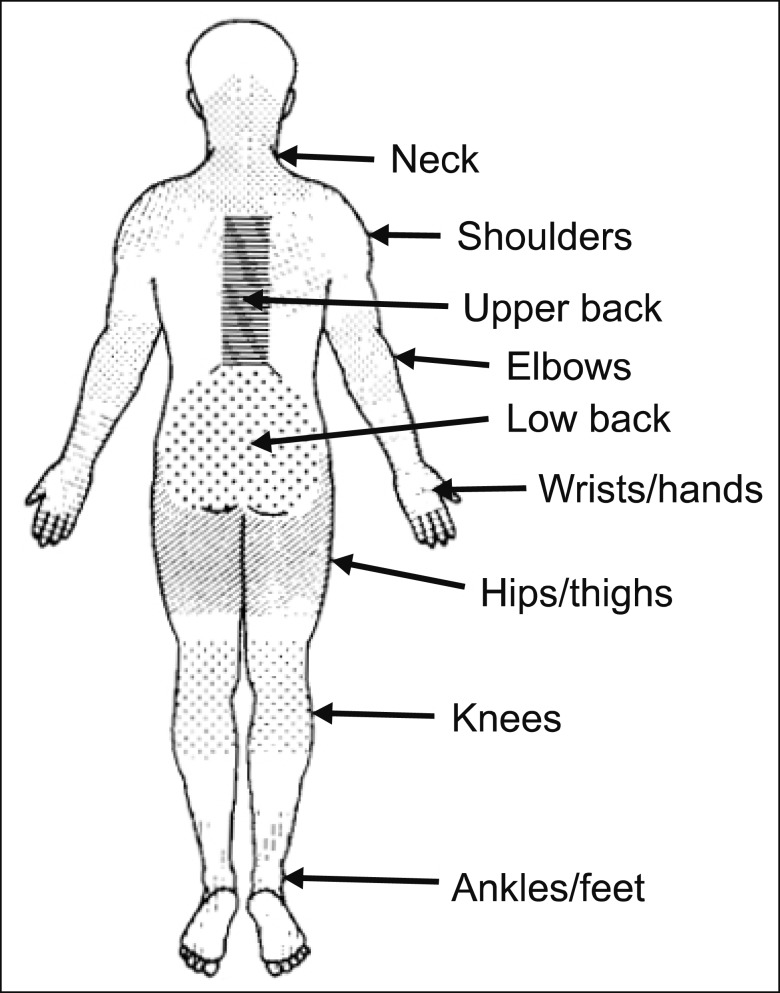Korean J Pain.
2018 Oct;31(4):268-276. 10.3344/kjp.2018.31.4.268.
Adaptation and validation of body maps for musculoskeletal pain location in patients with severe obesity
- Affiliations
-
- 1Graduate Program in Health Sciences, The Medical School of the Federal University of Goiás, Goiás, Brazil. carol_mendonca85@hotmail.com
- 2Instituto Federal Goiano - Campus Ceres, Goiás, Brazil.
- KMID: 2421518
- DOI: http://doi.org/10.3344/kjp.2018.31.4.268
Abstract
- BACKGROUND
Although a variety of instruments implement body maps for the precise identification of pain symptoms, no instrument has been validated for use in people with obesity. This study reports the adaptation and validation of body maps for musculoskeletal pain location in people with obesity.
METHODS
Nine key anatomical regions were highlighted based on the original images of the Nordic Musculoskeletal Questionnaire body maps. Adult silhouettes were generated from photographs of men and women with obesity. The body dimensions were adjusted to take into account the different body fat distribution patterns of people with obesity. The validity of the images was assessed by 12 experts. Subsequently, a data collection stage was performed with 58 patients with severe obesity from both sexes. The reproducibility of the images was tested by comparison with the original images.
RESULTS
The results of the validation pilot study indicated that the adapted images facilitated the location of musculoskeletal pain in men and women with obesity. The reproducibility of the original and adapted versions of the body maps indicated good agreement for pain over the last 12 months and 7 days (80% vs. 79.7%). Pain scores in the last 12 months indicated good and high sensitivity and specificity for all body areas (60.9% vs. 89.1%). Considering pain in the last 7 days, high sensitivity and specificity for all areas of the body (85.1% vs. 70.1%).
CONCLUSIONS
The body maps developed in this study are reliable and valid to identify the location of pain in people with obesity.
MeSH Terms
Figure
Cited by 1 articles
-
High prevalence of musculoskeletal pain in individuals with severe obesity: sites, intensity, and associated factors
Carolina Rodrigues Mendonça, Matias Noll, Annelisa Silva e Alves de Carvalho Santos, Ana Paula dos Santos Rodrigues, Erika Aparecida Silveira
Korean J Pain. 2020;33(3):245-257. doi: 10.3344/kjp.2020.33.3.245.
Reference
-
1. Caberlon CF, Padoin AV, Mottin CC. Importance of musculoskeletal pain in work activities in obese individuals. Obes Surg. 2013; 23:2092–2095. PMID: 23836042.
Article2. MacKichan F, Wylde V, Dieppe P. The assessment of musculoskeletal pain in the clinical setting. Rheum Dis Clin North Am. 2008; 34:311–330. PMID: 18638679.
Article3. Jensen MP, Karoly P. Self-report scales and procedures for assessing pain in adults. In : Turk DC, Melzack R, editors. Handbook of pain assessment. 3rd ed. New York (NY): Guilford Press;2011. p. 19–44.4. Brummett CM, Bakshi RR, Goesling J, Leung D, Moser SE, Zollars JW, et al. Preliminary validation of the Michigan body map. Pain. 2016; 157:1205–1212. PMID: 26835782.
Article5. Azevedo L, Costa Pereira A, Dias CC, Agualusa L, Lemos L, Romão J, et al. Tradução, adaptação cultural e estudo multicêntrico de validação de instrumentos para rastreio e avaliação do impacto da dor crónica. Pain (Portugal). 2007; 15:6–56.6. Jaatun EA, Hjermstad MJ, Gundersen OE, Oldervoll L, Kaasa S, Haugen DF, et al. Development and testing of a computerized pain body map in patients with advanced cancer. J Pain Symptom Manage. 2014; 47:45–56. PMID: 23856098.
Article7. NCD Risk Factor Collaboration (NCD-RisC). Trends in adult body-mass index in 200 countries from 1975 to 2014: a pooled analysis of 1698 population-based measurement studies with 19·2 million participants. Lancet. 2016; 387:1377–1396. PMID: 27115820.8. Melzack R. The McGill Pain Questionnaire: major properties and scoring methods. Pain. 1975; 1:277–299. PMID: 1235985.
Article9. Tan G, Jensen MP, Thornby JI, Shanti BF. Validation of the Brief Pain Inventory for chronic nonmalignant pain. J Pain. 2004; 5:133–137. PMID: 15042521.
Article10. Kuorinka I, Jonsson B, Kilbom A, Vinterberg H, Biering-Sørensen F, Andersson G, et al. Standardised Nordic questionnaires for the analysis of musculoskeletal symptoms. Appl Ergon. 1987; 18:233–237. PMID: 15676628.
Article11. Pull CB, Aguayo GA. Assessment of body-image perception and attitudes in obesity. Curr Opin Psychiatry. 2011; 24:41–48. PMID: 21088582.
Article12. Zamariola G, Cardini F, Mian E, Serino A, Tsakiris M. Can you feel the body that you see? On the relationship between interoceptive accuracy and body image. Body Image. 2017; 20:130–136. PMID: 28212526.
Article13. Luongo MA, Pazzaglia M. Commentary: body image distortion and exposure to extreme body types: contingent adaptation and cross adaptation for self and other. Front Hum Neurosci. 2016; 10:526. PMID: 27818630.
Article14. Pinheiro FA, Tróccoli BT, Carvalho CV. Validity of the Nordic Musculoskeletal Questionnaire as morbidity measurement tool. Rev Saude Publica. 2002; 36:307–312. PMID: 12131969.15. de Barros EN, Alexandre NM. Cross-cultural adaptation of the Nordic musculoskeletal questionnaire. Int Nurs Rev. 2003; 50:101–108. PMID: 12752909.
Article16. Labbafinejad Y, Danesh H, Imanizade Z. Assessment of upper limb musculoskeletal pain and posture in workers of packaging units of pharmaceutical industries. Work. 2017; 56:337–344. PMID: 28211842.
Article17. Wong K, Grundfast KM, Levi JR. Assessing work-related musculoskeletal symptoms among otolaryngology residents. Am J Otolaryngol. 2017; 38:213–217. PMID: 28129913.
Article18. Kaliniene G, Ustinaviciene R, Skemiene L, Vaiciulis V, Vasilavicius P. Associations between musculoskeletal pain and work-related factors among public service sector computer workers in Kaunas County, Lithuania. BMC Musculoskelet Disord. 2016; 17:420. PMID: 27717347.
Article19. Feng Q, Liu S, Yang L, Xie M, Zhang Q. The prevalence of and risk factors associated with musculoskeletal disorders among sonographers in Central China: a cross-sectional study. PLoS One. 2016; 11:e0163903. PMID: 27695095.
Article20. Legault EP, Cantin V, Descarreaux M. Assessment of musculoskeletal symptoms and their impacts in the adolescent population: adaptation and validation of a questionnaire. BMC Pediatr. 2014; 14:173. PMID: 24992817.
Article21. Ribeiro T, Serranheira F, Loureiro H. Work related musculoskeletal disorders in primary health care nurses. Appl Nurs Res. 2017; 33:72–77. PMID: 28096027.
Article22. Antonopoulou M, Antonakis N, Hadjipavlou A, Lionis C. Patterns of pain and consulting behaviour in patients with musculoskeletal disorders in rural Crete, Greece. Fam Pract. 2007; 24:209–216. PMID: 17504775.
Article23. Chanchai W, Songkham W, Ketsomporn P, Sappakitchanchai P, Siriwong W, Robson MG. The impact of an ergonomics intervention on psychosocial factors and musculoskeletal symptoms among Thai hospital orderlies. Int J Environ Res Public Health. 2016; 13:E464. PMID: 27153076.
Article24. Tantawy SA, Abdul Rahman A, Abdul Ameer M. The relationship between the development of musculoskeletal disorders, body mass index, and academic stress in Bahraini University students. Korean J Pain. 2017; 30:126–133. PMID: 28416996.
Article25. Ministério da Saúde (BR). Conselho Nacional de Saúde. Resolução no 466, de 12 de dezembro de 2012. Brasilia: Diário Oficial da União;2013.26. Pi-Sunyer FX, Becker DM, Bouchard C, Carleton RA, Colditz GA, Dietz WA, et al. Clinical guidelines on the identification, evaluation, and treatment of overweight and obesity in adults: the evidence report. Am J Clin Nutr. 1998; 68:899–917. PMID: 9771869.27. Kelsey JL, Bachrach LK, Procter-Gray E, Nieves J, Greendale GA, Sowers M, et al. Risk factors for stress fracture among young female cross-country runners. Med Sci Sports Exerc. 2007; 39:1457–1463. PMID: 17805074.
Article28. Karastergiou K, Smith SR, Greenberg AS, Fried SK. Sex differences in human adipose tissues - the biology of pear shape. Biol Sex Differ. 2012; 3:13. PMID: 22651247.
Article29. Świder K, Bąbel P. The effect of the type and colour of placebo stimuli on placebo effects induced by observational learning. PLoS One. 2016; 11:e0158363. PMID: 27362552.
Article30. Grant JS, Davis LL. Selection and use of content experts for instrument development. Res Nurs Health. 1997; 20:269–274. PMID: 9179180.
Article31. Terwee CB, Bot SD, de Boer MR, van der Windt DA, Knol DL, Dekker J, et al. Quality criteria were proposed for measurement properties of health status questionnaires. J Clin Epidemiol. 2007; 60:34–42. PMID: 17161752.
Article32. Jones GT, Kyabaggu R, Marais D, Macfarlane GJ. Reproducibility of pain manikins: a comparison of paper versus online questionnaires. Br J Pain. 2013; 7:130–137. PMID: 26516514.
Article33. Cohen J. A coefficient of agreement for nominal scales. Educ Psychol Meas. 1960; 20:37–46.
Article34. Viera AJ, Garrett JM. Understanding interobserver agreement: the kappa statistic. Fam Med. 2005; 37:360–363. PMID: 15883903.35. Gilpin HR, Moseley GL, Stanton TR, Newport R. Evidence for distorted mental representation of the hand in osteoarthritis. Rheumatology (Oxford). 2015; 54:678–682. PMID: 25246638.
Article36. Hamill JK, Cole AM, Liley A, Hill AG. Validity and reliability of a pain location tool for pediatric abdominal surgery. Pain Manag Nurs. 2015; 16:380–387. PMID: 26025797.
Article
- Full Text Links
- Actions
-
Cited
- CITED
-
- Close
- Share
- Similar articles
-
- High prevalence of musculoskeletal pain in individuals with severe obesity: sites, intensity, and associated factors
- The use of platelet-rich plasma in management of musculoskeletal pain: a narrative review
- The profile of musculoskeletal pain and its associations with sleep quality and depression during the COVID-19 in Turkey
- Stochastic Resonance Whole-Body Vibration, Musculoskeletal Symptoms, and Body Balance: A Worksite Training Study
- Cross-cultural adaptation and validation of the Turkish Yellow Flag Questionnaire in patients with chronic musculoskeletal pain



